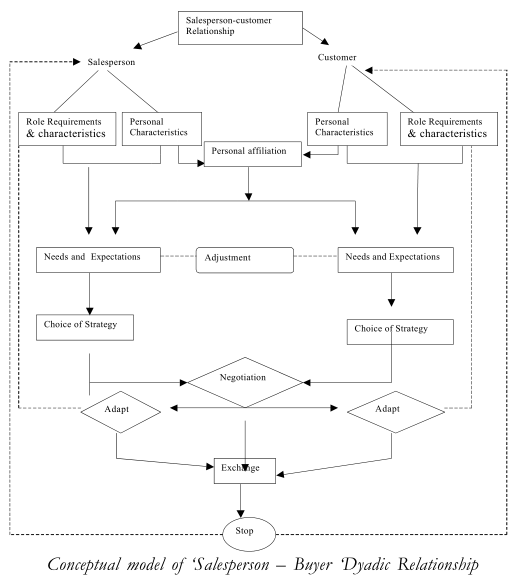Let us understand what is Buyer Seller Dyad? Fundamental to understanding salesmanship is recognition that it involves buyer-seller interactions. Sociologists use the term “dyad” to describe a situation in which two people interact. The salesperson and the prospect, interacting with each other, constitute one example of a “buyer-seller dyad”. Another is the interaction of a seller using advertising with a particular prospect in the reading, listening, or viewing audience. In both advertising and personal selling, the seller seeks to motivate the prospective buyer to behave favorably toward the seller. Whether or not the buyer reacts as the seller desires depends upon the nature of the interaction. The opportunity for interaction is less in the advertising case than in personal selling. However, advertising and personal selling often supplement or support each other, and the buyer reacts to their combined impact.
Franklin Evans researched buyer-seller dyads in the life insurance business. Prospects who bought insurance knew more about salespersons and their companies, and felt more positively toward them, than did prospects who did not buy, Further- more, the more alike salespersons and their prospects were, the greater was the likelihood that a sale would result. This was true for physical characteristics (age, height), other objective factors (income, religion, education), and variables that relate to personality factors (politics, smoking).
Evan’s findings have significance for sales management. Whenever possible, sales personnel should be assigned to prospects whose characteristics are similar to their own, thus improving the chance of successful dyadic relationships. Pairing salespersons with customers of similar backgrounds is more easily accomplished in industrial selling, where there are fewer prospects about whom information is needed, than in consumer goods selling, where the number of prospects and customers per salesperson is much larger.
Henry Tosi studied dyads of wholesale drug salespeople and retail pharmacists who made buying decisions. When the buyer perceived the salesperson’s performance to be similar to his or her concept of “ideal” performance, the number of sources from which purchases were made was low. Although this did not necessarily result in a larger percentage of purchases from the salesperson, customer satisfaction with the salesperson’s behavior did at least allow the salesperson to get into the store. Tosi concluded that, in addition to the physical characteristics and personality and objective factors cited by Evans, the customer’s perception of what that behavior should be is a necessary condition for the continuation of dyadic interaction.4
Another factor influencing buyer-seller dyadic interactions is the buyer’s initial conditioning with respect to selling. Salespeople have been maligned and the butt of nasty stories for generations. People are taught from childhood to beware of the tricky salesperson.
There are indications that salespeople, not as stereotyped, but as they actually perform, leave much to be desired in the impact they make on customers. Studies of the attitudes of buyers and purchasing agents reveal that many are critical of the salesperson’s lack of product knowledge, failure to follow up, general unreliability, slavish adherence to “canned” presentations, and blatant use of flattery, bad manners, commercial dishonesty, and so forth.
The Buyer-Seller Dyad
Good communication is a key to successful marketing, and it is particularly important for positive personal selling results. The buyer-seller dyad is flexible and efficient, closes sales, and provides feedback.


Figure in the last page is a conceptual model of “salesperson-buyer” dyadic relationships. This model, developed after an extensive literature search, views the sales process as being influenced by both salesperson and buyer, each a focal person influenced by personal characteristics and role requirements. Personal characteristic include personality, values, attitudes, past experiences, and the like. Role set requirements (for example, formal authority and organizational autonomy) interact with personal characteristic to shape needs and expectations. Focal persons’ perceptions of each other’s needs may lead to adjustments of their own (see the “feedback” mechanism represented by the broken lines in Figure 2.1).
Based on individual needs and expectations, each focal person develops a strategy aimed to negotiate a favorable exchange. That strategy may embrace persuasion, ingratiation, communication of facts or offers, friendship, and other elements. If the strategies are compatible, an exchange takes place. Otherwise, the salesperson and the buyer may stop interacting, or based on feedback from the unsuccessful negotiation, either or both may adapt by altering strategy, attempting to adjust needs and expectations, or modifying role requirements. Role requirements, as well as needs and expectations, often are determined by forces beyond the focal person’s control, so one or both may find it impossible to adapt. For instance, to meet a buyer’s expectations, a salesperson may need to set prices, yet this may be against company policy and beyond the salesperson’s control. When the particular round of negotiations is terminated regardless of its outcome, the experience becomes input into future interactions of the salesperson

